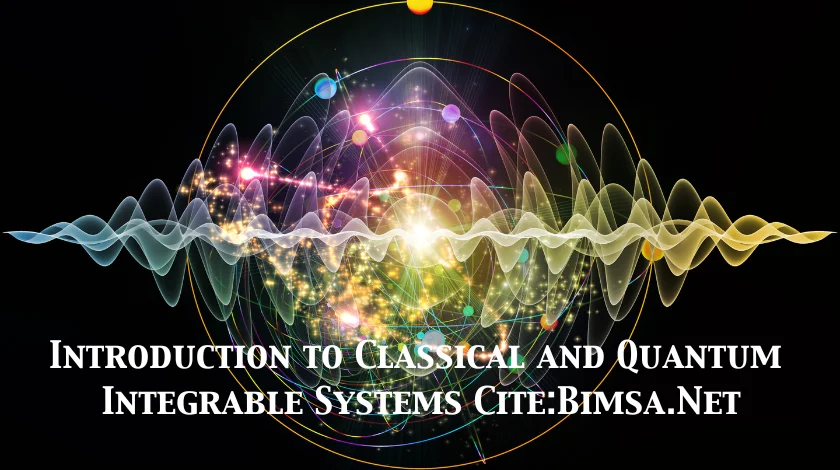Introduction to Classical and Quantum Integrable Systems Cite:Bimsa.Net
The world of physics is full of intriguing concepts, and among them lies the fascinating realm of integrable systems. Introduction to Classical and Quantum Integrable Systems Cite:Bimsa.Net Have you ever wondered how certain equations can be solved exactly while others remain elusive? This mystery unfolds within both classical and quantum frameworks, captivating mathematicians and physicists alike. As we embark on this exploration, you’ll discover not just what integrable systems are but also why they matter in our understanding of complex phenomena. Let’s dive into the intricate relationship between these two worlds—classical and quantum—and uncover their secrets together!
Explanation of Integrable Systems
Integrable systems are fascinating mathematical constructs that allow for exact solutions to complex problems. They arise in various fields, including physics and mathematics, where they simplify the analysis of dynamic behavior.
At their core, integrable systems possess a unique property: they can be solved using analytical methods rather than numerical approximations. This characteristic makes them invaluable tools for understanding dynamics over time.
The key aspect is the existence of enough conserved quantities or symmetries within the system. These enable long-term predictions about its evolution without losing accuracy.
From celestial mechanics to fluid dynamics, integrable systems offer profound insights into predictability amidst chaos. Their study reveals underlying patterns in seemingly random processes, bridging gaps between theory and real-world phenomena.
Classical Integrable Systems
Classical integrable systems are fascinating frameworks in mathematics and physics. They allow for the exact solutions of dynamic equations under specific conditions. This property makes them a rich area for exploration.
At their core, these systems can be described by Hamiltonian mechanics. Here, a set of conserved quantities ensures that motion remains predictable over time.
Consider the simple pendulum as an example. It showcases periodic motion without external forces influencing it, making calculations straightforward and intuitive.
Another classic instance is the Kepler problem, which deals with planetary orbits governed by gravitational interactions. Its elegant solutions reveal deep connections between geometry and celestial mechanics.
The beauty of classical integrable systems lies not just in their solvability but also in their ability to illustrate fundamental concepts within broader physical theories. Each system serves as a building block for understanding complex behaviors found throughout nature.
A. Definition
Integrable systems are a fascinating area of study in both classical and quantum mechanics. They refer to a special class of dynamical systems that can be solved exactly, allowing for precise predictions about their behavior over time.
In essence, an integrable system possesses enough conserved quantities or symmetries to make its equations solvable through analytical methods. Unlike more complex systems, which may exhibit chaotic behavior, these systems follow predictable paths.
Mathematically, integrable systems often arise when certain conditions are met. This includes the presence of sufficient degrees of freedom and specific constraints that enable integration. The beauty lies in how elegantly they can be analyzed with tools from geometry and algebra.
This definition sets the stage for exploring deeper into classical and quantum realms where integrability plays a crucial role in understanding physical phenomena.
B. Examples
Classical integrable systems are fascinating and diverse, showcasing the beauty of mathematics in motion. One prominent example is the simple harmonic oscillator. This system exemplifies predictable behavior with its regular oscillations.
Another classic example involves the Kepler problem, which describes planetary motion under gravitational influence. Here, we see a perfect balance between forces that leads to elliptic orbits—a true marvel of celestial mechanics.
Additionally, consider the Toda lattice. This one-dimensional model represents particles connected by exponential springs. Its integrability reveals rich structures and intriguing dynamics that resonate through various fields of physics.
Each of these examples illustrates how classical integrable systems can provide deep insights into both theoretical concepts and real-world phenomena. They highlight the interconnectedness between mathematical elegance and physical reality.
Quantum Integrable Systems
Quantum integrable systems extend the concept of classical integrability into the realm of quantum mechanics. They are characterized by their solvability, allowing for an exact determination of the system’s behavior over time.
A key feature is that these systems often maintain a vast number of conserved quantities. This makes it possible to derive insights about their dynamics and properties through sophisticated mathematical techniques.
Common examples include spin chains and certain models in condensed matter physics. These systems not only illustrate fundamental principles but also provide a playground for exploring complex phenomena like quantum entanglement.
Understanding quantum integrable systems opens doors to advancements in fields such as statistical mechanics and quantum computing. The interplay between classical structures and quantum behaviors presents exciting opportunities for research and application.
A. Definition
Integrable systems are a fascinating concept in both classical and quantum mechanics. At their core, these systems possess enough conserved quantities to allow for the complete solution of their dynamics. This means they can be described by a finite number of parameters.
In classical mechanics, integrable systems follow Hamiltonian dynamics. They exhibit predictable behavior over time due to their underlying symmetries and conservation laws. The key is that they can often be solved exactly using mathematical techniques.
In the realm of quantum physics, integrability takes on new dimensions. Quantum integrable systems maintain similar properties but within a framework governed by wave functions and operators. These systems reveal intricate relationships between energy levels and states.
Understanding what defines an integrable system opens up pathways into deeper areas of research in mathematics and physics, further illustrating the beauty behind orderly chaos in nature’s laws.
B. Examples
When exploring classical integrable systems, one often encounters the famous pendulum. Its behavior can be predicted using simple equations, making it a classic example of integrability in action.
Another noteworthy instance is the harmonic oscillator. This system’s energy levels are quantized and predictable, showcasing how integrable systems can provide insight into oscillatory motion.
The Korteweg-de Vries equation also stands out as a prime example. It describes shallow water waves and exhibits soliton solutions—stable waveforms that maintain their shape over time.
Consider the Liouville system in Hamiltonian mechanics. It encompasses multiple degrees of freedom while preserving its structure under certain transformations, highlighting the richness of integrability within complex scenarios.
These examples illustrate just how pervasive and influential classical integrable systems are across various fields of physics and mathematics.
Comparing Classical and Quantum Integrable Systems
Classical and quantum integrable systems, while rooted in the same mathematical principles, exhibit distinct characteristics. Classical integrable systems often rely on deterministic equations of motion governed by Hamiltonian mechanics. Their solutions can be expressed through well-defined functions like action-angle variables.
On the other hand, quantum integrable systems incorporate principles from quantum mechanics. Here, probabilities replace certainties, leading to a different landscape for understanding dynamics. The wave function plays a crucial role in determining system behavior.
The interplay between these two realms is fascinating. Classical chaos contrasts sharply with quantum coherence; while classical systems may become unpredictable under certain conditions, quantum systems maintain their structure due to superposition effects.
Understanding both types enriches our comprehension of physical phenomena across scales—from celestial mechanics down to subatomic particles—highlighting their unique yet interconnected nature within the broader scope of physics and mathematics.
Applications of Integrable Systems
Integrable systems find their way into various fields, proving their versatility and importance. In physics, they are essential for solving complex problems in mechanics and statistical models. Their ability to provide exact solutions helps researchers understand particle dynamics better.
In biology, integrable systems model population dynamics. By using these mathematical frameworks, scientists can predict how species interact over time. This has significant implications for conservation efforts.
Finance also benefits from integrable systems through risk assessment models that analyze market behaviors. They help identify trends and optimize investment strategies.
Moreover, engineering utilizes them in control theory to design robust mechanisms and streamline processes. The precision of integrable systems enhances the reliability of automated technologies.
These applications demonstrate the broad impact of integrable systems across disciplines. Each breakthrough opens new avenues for exploration and innovation in both theoretical research and practical implementations.
Challenges and Limitations in Studying Integrable Systems
Studying integrable systems presents several challenges that can hinder progress in the field. One primary issue is the complexity of mathematical models. Many integrable systems involve intricate equations that require advanced techniques to solve.
The transition from classical to quantum frameworks adds another layer of difficulty. Quantum mechanics introduces uncertainty and non-locality, complicating the analysis further.
Moreover, isolating essential variables while maintaining accuracy can be a daunting task. Researchers often grapple with simplifying assumptions that may overlook critical behaviors of the system.
Practical applications also face limitations. Real-world phenomena rarely adhere strictly to integrable conditions, making it hard to apply theoretical results directly.
Computational resources play a role too. As systems grow more complex, they demand increasingly sophisticated numerical methods and simulations, which are not always readily available or affordable for researchers.
Conclusion
Integrable systems play a crucial role in both classical and quantum physics. They offer deep insights into the underlying mechanics of diverse physical phenomena. Classical integrable systems allow us to explore traditional dynamics through well-understood mathematical structures, providing examples such as the harmonic oscillator and the Korteweg-de Vries equation.
On the other hand, quantum integrable systems introduce unique challenges and mysteries. They bridge our understanding of quantum mechanics with classical theories, paving new pathways for research. Examples like the Bethe ansatz highlight how these fascinating systems can yield rich results in theoretical physics.
While integrating both types uncovers similarities, it also reveals distinct differences that contribute to their complexity. The applications across various fields—ranging from statistical mechanics to string theory—demonstrate their significance in advancing scientific knowledge.
Despite their importance, studying integrable systems comes with challenges. Researchers must navigate intricate mathematics and evolving theories while confronting limitations inherent within different frameworks.
The exploration of classical and quantum integrable systems opens doors to future innovations and discoveries in science. Understanding these concepts will undoubtedly enhance our grasp on complex behaviors observed throughout nature.
















